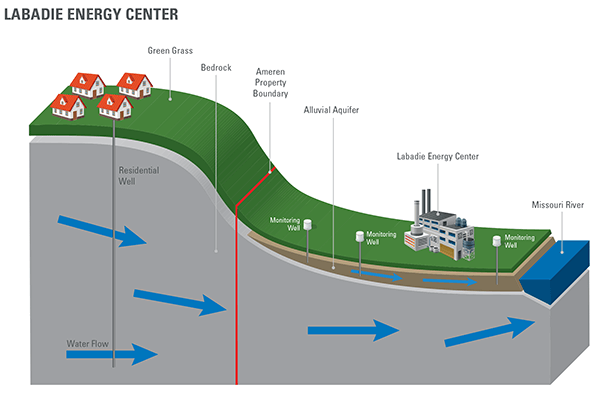Risk Assessments
Ameren Has Conducted Extensive Environmental Evaluations at the Missouri Energy Center
Before the federal CCR rule, Ameren engaged multiple independent experts to evaluate groundwater and surface water quality at our energy centers. Copies of those reports are available here and contain the following information:
- Groundwater Flow – determined and plotted direction, flow rate and water level readings for all energy center sites on surface contour maps.
- Public Water Supplies – identified the nearest location of public water supply intakes on the Missouri, Mississippi and Meramec Rivers. All such intakes are located miles from our facilities.
- Residential Wells – identified private and community drinking water wells located within a one-mile radius of the energy centers. In addition, Ameren installed offsite well networks at the Labadie and Rush Island Energy Centers to confirm that groundwater used by residential wells fully comply with drinking water standards.
- Surface Water Sampling – sampled the Missouri, Meramec and Mississippi Rivers and adjoining creeks and backchannels to determine water quality and whether the ash basins impact those surface water bodies.
- Risk Based Analysis – using flow rates for groundwater and surface water, calculated the concentration levels that would need to exist onsite before there could be an adverse impact to surface water. As detailed in risk assessment reports prepared by Haley & Aldrich, for such an adverse impact to exist, onsite groundwater concentrations at each of the energy centers would need to be multiples higher than current conditions.
Haley & Aldrich also evaluated the groundwater and surface water data sets for the following potential exposures: drinking water consumption, recreational use and fish consumption. The analysis included more than 15,000 data points. Haley & Aldrich concluded, using EPA and MDNR published criteria, that the basins do not present either an ecological or human health risk.
As detailed in the Haley & Aldrich 2018 reports, and under a risk-based analysis used by environmental regulators, for there to be a risk from a chemical constituent, there must first be a mechanism or physical pathway for such exposure to occur. With respect to the ash basins, such a pathway does not exist thus there is no human exposure to groundwater impacted by coal ash constituents. Concentration levels of certain constituents above drinking water standards do not equate to a health risk because a pathway of exposure, is absent.

